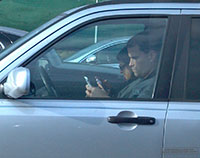
23 Apr Cell Phones and Driving Safety
The use of smartphones has had a dramatic effect on highway safety – and not in a positive way.
Approximately one quarter of car crashes involves driver distraction, and drivers who operate their vehicles while using cell phones are at a greater risk of collision than those who don’t. This is why many states and local municipalities have elected to enact legislation that restricts the use of cell phones during the operation of a motor vehicle, and this can include both talking and texting.
Cell Phones and Driving: New Restrictions are in Place
While Texas currently has no statewide law that bans the use of cell phones during the operation of a motor vehicle, there are many local ordinances (e.g. Denton, TX; Farmers Branch, TX; and Arlington, TX) that either prohibit or limit the use of cell phones by the driver of a motor vehicle. Even when there is no law restricting the use of a cell phone when driving, safety experts recommend waiting until after you arrive at your destination to talk on the phone, or if you must make a phone call right away, pull over to the side of the road. This is for your own protection as well as that of others on the road.
Some of the current restrictions in place in Texas include the following:
- Drivers who are operating on only learners permits are not permitted to use handheld cell phones until they have been driving for at least six months.
- Drivers under the age of 18 are not permitted to use wireless communication devices while driving.
- It is illegal for school bus drivers to use cell phones while they are driving if children are on the bus.
- It is illegal for any driver to use a handheld device when they are in school crossing zones.
- It is illegal for any commercial vehicle operator (18-wheelers, busses, etc) to text while driving.
Alarming Statistics: It Isn’t Getting Any Better
Cell phones had become so popular by 1997 that the National Highway Traffic Safety Administration conducted a study in order to assess the potential dangers that were involved in the growing use of these wireless devices. This study was neither the first nor the last one that was designed to assess the need for pursuing safety measures for cell phone use.
Increase in Dangerous Vehicle Incidents
The purpose of the NHTSA study was to alert people of the alarming increase in distractions cell phone use posed for drivers. As the agency analyzed the crash data, it discovered there was a substantial amount of information. In fact, some of the study results actually seemed potentially erroneous or inconclusive because those results were based on limitations in the crash data that was used to obtain the study results. The end result stated that the use of cellular phones was a trend that had become a growing contributory factor in crashes. If you have been injured in an accident caused by a driver using their cellphone, you may hire an auto accident attorney who can help protect your rights. Experienced car accident attorneys and accident lawyers can guide you in filing a claim and seek the compensation you deserve.
Effects of Cell Phones on Driving Incidents
There are two primary types of cell phone behavior that tend to cause unsafe driving conditions:
- Dialing, answering, text messaging, or other activity related to the use of the phone.
- The conversation that transpires between the driver and the person on the other end of the phone.
A report by the National Safety Council conducted simulated driving tests that showed subjects who carried on cell phone conversations were sometimes so distracted they weren’t even aware of traffic signals. The study examined the psychology of a conversation, especially how it related to the level of participation when compared to other types of listening behaviors such as simply listening to audio books or news radio. Reportedly, when a subject is emotionally engaged, he or she will not be as attentive to safety signals, and the results were no different for subjects who used hands free devices.
Cell phone use has become a big problem with drivers, and many states are enacting regulations to restrict their use. This study shows that even those who use hands free devices can still be distracted simply from engaging in a conversation on the phone. Stricter legislation is necessary in order to reduce the incidents that result from cell phone use, both talking and texting.









Sorry, the comment form is closed at this time.